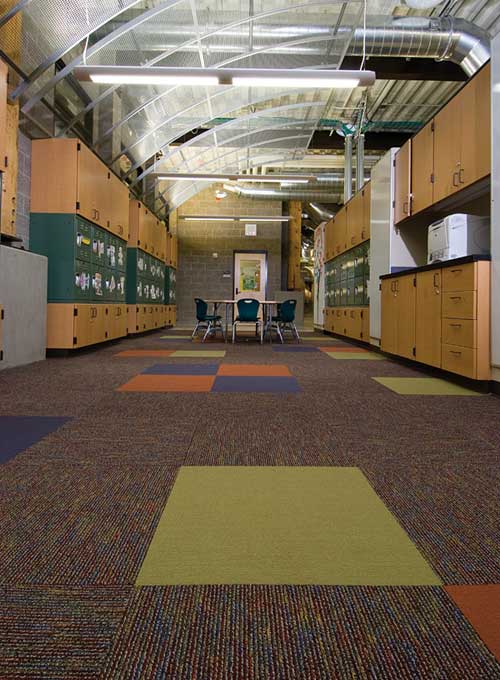Carpet for Schools: A Sustainable Solution that Enhances Learning and Health
SUSTAINABILITY
With the plethora of carpet types available in the marketplace, selecting the most sustainable carpet can be a challenge. NSF 140-2007, certified by the American National Standards Institute (ANSI), is the prevailing sustainable carpet assessment standard. The standard is voluntary, based on life-cycle assessment principles, and provides a single rating system that recognizes levels of achievement - mandatory minimum standards of sustainable performance as well as silver, gold and platinum levels that define a more sustainable carpet. It establishes performance requirements and quantifiable metrics throughout the supply chain for public health and environment; energy and energy efficiency; bio-based, recycled content materials; manufacturing; and reclamation and end of life management. While the standard can be used to evaluate any carpet product, it is primarily intended for commercial carpets as its evaluation methodology is complementary to emerging commercial green building standards.
Selecting the Right Carpet. In many instances, new schools have incorporated a mix of floor coverings, with carpet in entrances and corridors to minimize dirt brought in and spread throughout the facility. Carpeting in these areas also provides extra traction for school children entering the building, particularly when it's wet or snowy outside. In elementary school classrooms carpeting is increasingly being used around teachers' and students' desks, with smooth surfaces reserved for around sinks and water fountains and in bathrooms and cafeterias.
Since choosing the right carpet is critical, the industry has developed guidelines to assist design professionals in selecting commercial carpet with acceptable texture retention performance in specific end-use applications (www.carpet-rug.org/pdf_word_docs/fact_sheets/CRI_Factsheet_TARR.pdf).
The Texture Appearance Retention Rating (TARR) system identifies the level of appearance change of a carpet surface resulting from foot traffic. Developed through a consensus process involving technical experts in the carpet industry and commercial and government specifiers, TARR ratings identify changes in appearance on a 1 to 5 numbered scale: 5 represents no change in appearance and 1 represents a very severe change from the original texture of the pile yarn expected in a given traffic area during the first year after installation. Carpet with a higher rating, such as 4.5 or 4.0, will retain its original new appearance longer under various traffic conditions than carpet with a lower rating. The rating does not reflect the potential influence of variable factors such as soiling, staining, maintenance and improper installation. To obtain the projected appearance retention performance, the carpet must be correctly installed following the manufacturer's instructions and in accordance with industry installation guidelines. Design professionals note TARR numbers on commercial projects.
The guidelines classify moderate, heavy, severe, or special enduse for each application based on the level of expected foot traffic. For example, school offices are classified as moderate use (> 2.5 TARR); school classrooms, conference rooms, lounges and libraries and classified as heavy use (> 3.0 TARR); and school corridors, entrances and lobbies are classified as severe use (> 3.5 TARR).
 |
Variation in color and pattern can mask the effects of traffic in school settings. Photo courtesy of the Carpet and Rug Institute |









